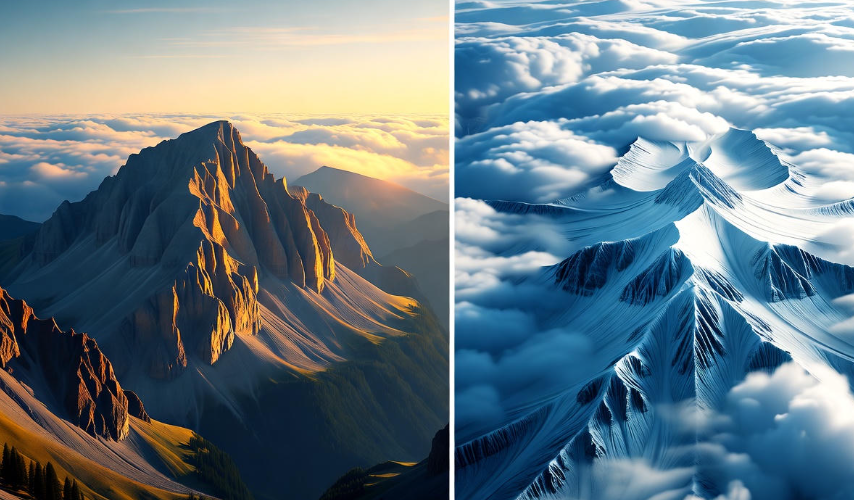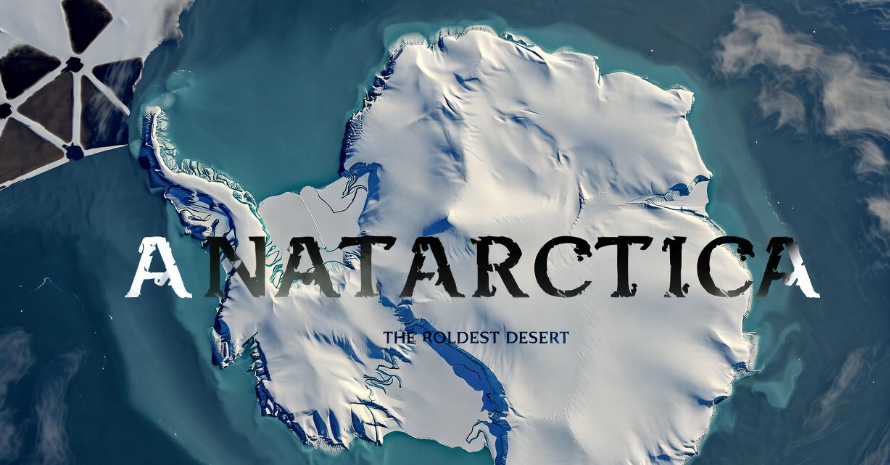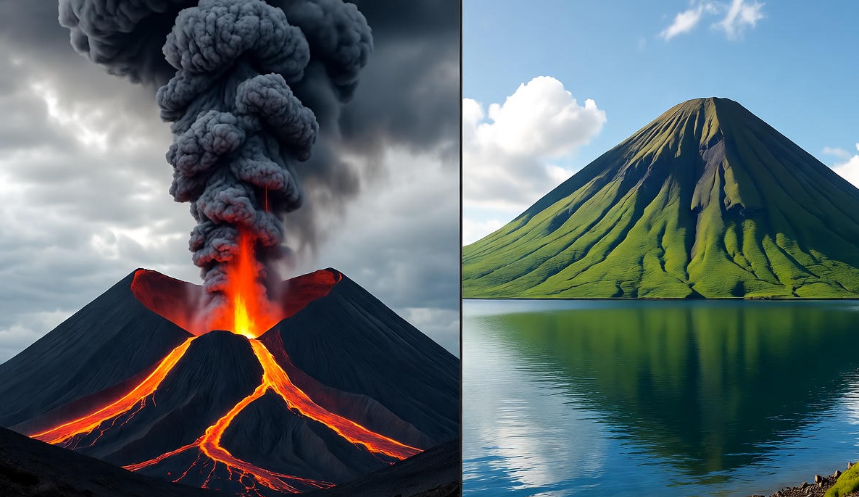Have you ever stood before a giant mountain and wondered how something so huge came to be? ⛰️
It’s one of nature’s greatest wonders — those tall, rugged peaks that reach for the sky. Mountains aren’t just beautiful; they’re powerful forces that shape our planet in ways we often don’t even realize.
Let’s go step-by-step through how mountains form, grow, and even affect life all around them — from weather patterns to the land we live on.
What Exactly Is a Mountain?
A mountain is a large landform that rises high above the surrounding ground, usually with steep sides and a peak at the top.
But there’s no single height that makes something a mountain — it’s more about how it looks compared to its surroundings.
Most geographers agree: if it’s higher than about 600 meters (2,000 feet), it’s usually called a mountain.
Below that? It’s more likely a hill.
| Feature | Hill | Mountain |
|---|---|---|
| Height | Less than 600m | More than 600m |
| Slope | Gentle | Steep |
| Formation | Usually from erosion or small movements | Often from tectonic forces |
| Example | The Cotswolds (UK) | Mount Everest (Nepal) |
How Do Mountains Form?
Mountains don’t just appear overnight — they take millions (sometimes hundreds of millions) of years to form. The Earth’s crust is constantly moving, even if we can’t feel it.
It’s made up of large sections called tectonic plates, like pieces of a giant jigsaw puzzle that fit together but are always shifting slightly. When these plates move, collide, or slide past each other, they create massive pressure — and that’s when mountains start to rise.
There are five main types of mountains, depending on how they form. Let’s explore each one.
1. Fold Mountains ️
These are the most common type. They form when two tectonic plates push against each other, forcing the land between them to buckle and fold upward — just like when you push the ends of a rug together and it wrinkles.
Examples include:
-
The Himalayas (Asia) — formed when India collided with Asia.
-
The Andes (South America).
-
The Rocky Mountains (North America).
| Feature | Fold Mountains |
|---|---|
| Cause | Collision of tectonic plates |
| Example | Himalayas, Andes |
| Age | Usually young and tall |
| Structure | Layers of rock folded over each other |
Interesting fact: The Himalayas are still growing taller today — about 5 millimeters each year!
2. Fault-Block Mountains ⛰️
These form when the Earth’s crust cracks, creating fault lines. Blocks of rock either drop down or get pushed up along these faults. The raised parts form mountains, and the dropped parts become valleys.
Examples:
-
The Sierra Nevada (USA).
-
The Harz Mountains (Germany).
| Feature | Fault-Block Mountains |
|---|---|
| Cause | Movement along faults |
| Example | Sierra Nevada |
| Appearance | Steep front, flat top |
| Rocks | Older and harder |
These mountains look dramatic because of their sharp cliffs and flat peaks — nature’s version of a broken staircase!
3. Volcanic Mountains
As you might guess, these form when magma (hot molten rock) from deep inside the Earth pushes its way to the surface. When it erupts, the lava cools and piles up, creating a cone-shaped mountain.
Examples:
-
Mount Fuji (Japan)
-
Mount St. Helens (USA)
-
Mount Kilimanjaro (Tanzania)
| Feature | Volcanic Mountains |
|---|---|
| Cause | Eruption of magma |
| Example | Mount Fuji |
| Material | Lava, ash, and rock |
| Shape | Cone or dome |
Over thousands of years, layer after layer of cooled lava builds up these amazing natural giants.
-
️ Recommended for you: The Most Populated Cities in the World 2025
4. Dome Mountains
Sometimes magma pushes up from below the crust but doesn’t break through. Instead, it causes the surface to swell upward like a bubble. The magma eventually cools, and erosion wears away the outer layers, leaving the dome-shaped mountain exposed.
Examples:
-
The Black Hills (USA).
-
Laccolith Mountains in Utah.
| Feature | Dome Mountains |
|---|---|
| Cause | Magma pushing up under the crust |
| Example | Black Hills |
| Shape | Rounded, dome-like |
| Rock Layers | Tilted outward from the center |
They’re like hidden volcanoes that never erupted!
5. Plateau Mountains (Erosional Mountains) ️
These aren’t formed by movement from below but by erosion — the slow wearing away of rock over millions of years. Wind, rain, rivers, and glaciers carve deep valleys, leaving tall plateaus or isolated peaks behind.
Examples:
-
The Scottish Highlands
-
The Catskill Mountains (USA)
| Feature | Plateau Mountains |
|---|---|
| Cause | Erosion of elevated land |
| Example | Scottish Highlands |
| Appearance | Flat-topped, broad |
| Rock Type | Sedimentary or metamorphic |
So, some mountains grow from below — others are sculpted from above!
The Role of Plate Tectonics
Tectonic activity is the real architect behind most mountains. When plates move, they cause earthquakes, volcanoes, and of course — mountain building.
Here’s a simple table to show how plate movements lead to different landforms:
| Plate Movement | Example | Landform Created |
|---|---|---|
| Plates collide | India meets Asia | Fold Mountains |
| Plates pull apart | Mid-Atlantic Ridge | Volcanic Mountains |
| Plates slide past | San Andreas Fault | Fault-Block Mountains |
The Earth’s crust might seem solid, but it’s always in slow motion. That’s why the Himalayas are growing, while older mountains like the Appalachians are wearing down.
How Mountains Shape the Earth ️
Mountains aren’t just big piles of rock — they change everything around them, from weather to wildlife.
Let’s see how:
-
They influence climate – Mountains act like giant walls that block winds and clouds.
-
One side (called the windward side) gets rain.
-
The other side (leeward side) often stays dry — forming deserts.
Example: The Atacama Desert lies behind the Andes because mountains stop moist air from reaching it.
-
-
They store water – Snow that falls on mountain tops melts in summer and feeds rivers. This water supports millions of people downstream.
-
The Himalayas are sometimes called the “Water Towers of Asia.”
-
-
They affect air – Mountains force air to rise and cool, making clouds and rain. Without them, many areas would be dry and lifeless.
-
They create unique ecosystems – Each elevation zone supports different plants and animals.
For example:-
Base: dense forests
-
Middle: grasslands
-
Top: snow and hardy moss ❄️
-
-
They shape human life – People living near mountains develop special ways of life — farming on terraces, using mountain streams for power, and building roads that twist through valleys.
How Mountains Erode and Change Over Time ️
Mountains might seem eternal, but they don’t last forever. Rain, ice, and wind slowly wear them down.
Even rivers cut through mountains to form valleys and gorges — like the Grand Canyon, which was carved by the Colorado River.
Here’s a quick breakdown of how erosion works:
| Erosive Force | Result |
|---|---|
| Rain & Rivers | Valleys and canyons |
| Wind | Smooth slopes |
| Glaciers | U-shaped valleys |
| Gravity | Landslides and rockfalls |
Over millions of years, today’s tall peaks will become rolling hills — and one day, plains.
Mountains and Natural Resources
Mountains are full of valuable resources — not just scenic beauty!
They contain minerals like gold, copper, coal, and iron, which people have mined for centuries.
They’re also home to forests, rivers, and fertile soil, supporting agriculture and tourism.
However, mining and deforestation can harm mountain environments. So, protecting them is crucial — for us and future generations.

Mountains and Human Life
People have always been drawn to mountains — for protection, fresh water, or spiritual peace. Many cultures even see mountains as sacred places.
For example:
-
Mount Fuji in Japan
-
Mount Sinai in Egypt
-
Machu Picchu in the Andes
Mountain life is not easy though. Roads are hard to build, winters are long, and farming is limited. Yet, mountain people are known for their strength and adaptability.
Fun Facts About Mountains
| Fact | Description |
|---|---|
| Tallest Mountain (above sea level) | Mount Everest (8,848 m) |
| Tallest from base to peak | Mauna Kea, Hawaii (over 10,000 m from seafloor) |
| Oldest Mountain Range | Barberton Greenstone Belt, South Africa (3.2 billion years old) |
| Fastest Growing Mountains | The Himalayas |
| Most Isolated Peak | Mount Kilimanjaro |
Did you know? If you could flatten all the Earth’s mountains, our planet would actually be covered by a much deeper ocean!
Why Mountains Matter More Than You Think
Mountains are the lungs of the planet — they store water, generate clean air, and provide a home to nearly 15% of the world’s population.
They also shelter thousands of unique species that don’t exist anywhere else.
So, when mountains suffer — from pollution, deforestation, or climate change — the whole Earth feels it.
We need to take care of them by promoting eco-tourism, planting trees, and reducing carbon footprints.
Because protecting mountains means protecting life itself.
FAQs About Mountains ❓
Q1. How long does it take for a mountain to form?
It can take millions of years for mountains to rise. For example, the Himalayas started forming about 50 million years ago — and they’re still growing!
Q2. Why are some mountains volcanic?
Volcanic mountains form when magma erupts through the Earth’s surface. Over time, lava builds up layer by layer, forming a mountain.
Q3. Are all mountains made of the same type of rock?
No. Some are made of sedimentary rocks (like limestone), others of igneous or metamorphic rocks — depending on how they formed.
Q4. Can mountains disappear?
Yes — slowly! Erosion and weathering wear them down. Very old mountain ranges, like the Appalachians, were once as tall as the Himalayas but have been worn smooth over time.
Q5. What’s the difference between a mountain and a volcano?
All volcanoes are mountains, but not all mountains are volcanoes. Volcanoes form from magma; other mountains form by tectonic forces or erosion.
Final Thoughts
Mountains tell the story of our Earth’s past — from fiery volcanoes to crashing tectonic plates. They shape our world, control our climate, and give us water, minerals, and breathtaking beauty.
Every mountain you see is a reminder that the Earth is alive — moving, changing, and growing all the time.
So next time you look at one, take a deep breath and remember: you’re looking at millions of years of history standing right in front of you.




